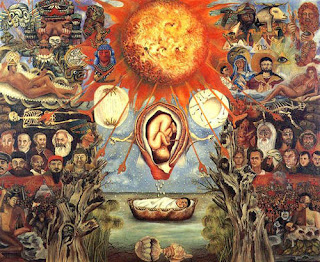A union between an elephant and a dove. This is how Frida Kahlo’s marriage was described with her husband Diego Rivera due to his outlandishly large build and her petite figure just over five feet tall. Their complicated love had several highs and lows, but all the while arguing and learning from each other. Both of their lives as artists portray their difference in opinion. Scott Gilbert’s Fertilization Narratives in the Art of Gustav Klimt, Diego Rivera and Frida Kahlo: Repression, Domination and Eros among cells examines two of their paintings, both of which depict their view on sexual relations, fertilization, and government control. While Rivera’s mural depicts the control man has in regulating human fertilization, Kahlo’s painting refutes this in her painting by portraying embryo formation as an ultimate act of love and the center of all life.
Diego Rivera uses a series of different images to help depict the illusion of man control of both the physical and biological world. In the article, Gilbert analyzes the painting and makes several conclusions using background knowledge and inferences. First, at the center of the mural is a gloved man who apparently seems to be working some controls. These can be assumed to be controlling all that is going on around him. Crossing through him are two oval shapes with several images inside. One portrays icons that can represent the physical world, such as planets and stars flying, while the other show biological figures including cells and vegetation. Also right under the man is a hand grasping a ball that is supposed to represent a fertilized ovary. All of these images combined give the effect of man’s advances in science to be able to control the world around him, such as biology, physics, and most importantly, reproduction.
Frida Kahlo’s painting Moses (the Nucleaus of Creation) gives a much lighter view on the topic of fertilization. Gilbert again uses several observations to draw a conclusion about the purpose of her artwork. First is the use of tripartite painting, or dividing the painting into three sections. However, when the picture is looked at in a broader view, it appears almost as if the whole image depicts one large uterus and ovary system. Also, at the very center of her creation is a developed baby in a uterus. She puts this here trying to show that a women’s fertility is the center of the universe. She puts the faces of many religious men around the womb. This is to drive home the importance that without fertilization, none of these would be in existence. Kahlo also uses other images around this to strengthen the point of its importance. For example, there are textbook like drawings of cellular processes of mitosis. She uses these as proof that fertilization is the basis of all life. From interviews, it becomes apparent that fertilization is a symbol for ultimate love. She believes this because of her studies in medicine. Even though sperm and egg are both “on the point of death” their union creates a rejuvenated individual that carries on the life (Gilbert). The use of background knowledge and observations from her painting, we can see her view of procreation as an act of ultimate love and the center of all life.
Though sharing a life together, both of these artists have completely different views on fertilization and how it should be approached. Gilbert’s article gives great examples of direct images that prove this idea. Perhaps it is because of this argument that led to their eventual divorce. No one will ever know, but we can be sure of their individual depictions of procreation and life in general.
Art is an important part of all societies. This holds true for UNC as well. There is art all over campus, from the paintings of billboards the the pit, to the galleries in the Ackland Art Museum. This artwork brightens up our day and also can give the inquisitive mind something to ponder over.


No comments:
Post a Comment